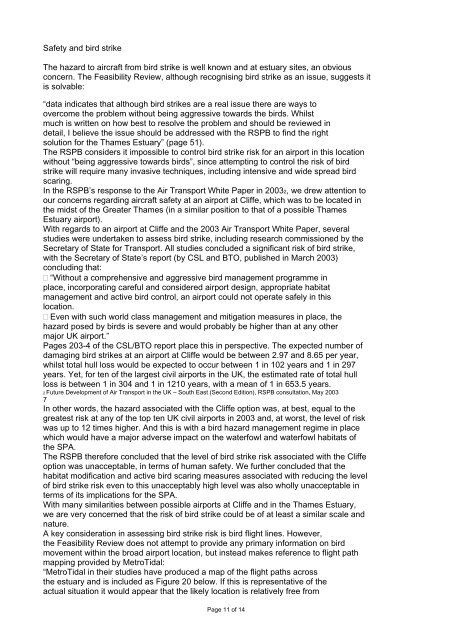1. Ecological objections - London
1. Ecological objections - London
1. Ecological objections - London
You also want an ePaper? Increase the reach of your titles
YUMPU automatically turns print PDFs into web optimized ePapers that Google loves.
Safety and bird strike<br />
The hazard to aircraft from bird strike is well known and at estuary sites, an obvious<br />
concern. The Feasibility Review, although recognising bird strike as an issue, suggests it<br />
is solvable:<br />
“data indicates that although bird strikes are a real issue there are ways to<br />
overcome the problem without being aggressive towards the birds. Whilst<br />
much is written on how best to resolve the problem and should be reviewed in<br />
detail, I believe the issue should be addressed with the RSPB to find the right<br />
solution for the Thames Estuary” (page 51).<br />
The RSPB considers it impossible to control bird strike risk for an airport in this location<br />
without “being aggressive towards birds”, since attempting to control the risk of bird<br />
strike will require many invasive techniques, including intensive and wide spread bird<br />
scaring.<br />
In the RSPB’s response to the Air Transport White Paper in 20032, we drew attention to<br />
our concerns regarding aircraft safety at an airport at Cliffe, which was to be located in<br />
the midst of the Greater Thames (in a similar position to that of a possible Thames<br />
Estuary airport).<br />
With regards to an airport at Cliffe and the 2003 Air Transport White Paper, several<br />
studies were undertaken to assess bird strike, including research commissioned by the<br />
Secretary of State for Transport. All studies concluded a significant risk of bird strike,<br />
with the Secretary of State’s report (by CSL and BTO, published in March 2003)<br />
concluding that:<br />
“Without a comprehensive and aggressive bird management programme in<br />
place, incorporating careful and considered airport design, appropriate habitat<br />
management and active bird control, an airport could not operate safely in this<br />
location.<br />
Even with such world class management and mitigation measures in place, the<br />
hazard posed by birds is severe and would probably be higher than at any other<br />
major UK airport.”<br />
Pages 203-4 of the CSL/BTO report place this in perspective. The expected number of<br />
damaging bird strikes at an airport at Cliffe would be between 2.97 and 8.65 per year,<br />
whilst total hull loss would be expected to occur between 1 in 102 years and 1 in 297<br />
years. Yet, for ten of the largest civil airports in the UK, the estimated rate of total hull<br />
loss is between 1 in 304 and 1 in 1210 years, with a mean of 1 in 653.5 years.<br />
2 Future Development of Air Transport in the UK – South East (Second Edition), RSPB consultation, May 2003<br />
7<br />
In other words, the hazard associated with the Cliffe option was, at best, equal to the<br />
greatest risk at any of the top ten UK civil airports in 2003 and, at worst, the level of risk<br />
was up to 12 times higher. And this is with a bird hazard management regime in place<br />
which would have a major adverse impact on the waterfowl and waterfowl habitats of<br />
the SPA.<br />
The RSPB therefore concluded that the level of bird strike risk associated with the Cliffe<br />
option was unacceptable, in terms of human safety. We further concluded that the<br />
habitat modification and active bird scaring measures associated with reducing the level<br />
of bird strike risk even to this unacceptably high level was also wholly unacceptable in<br />
terms of its implications for the SPA.<br />
With many similarities between possible airports at Cliffe and in the Thames Estuary,<br />
we are very concerned that the risk of bird strike could be of at least a similar scale and<br />
nature.<br />
A key consideration in assessing bird strike risk is bird flight lines. However,<br />
the Feasibility Review does not attempt to provide any primary information on bird<br />
movement within the broad airport location, but instead makes reference to flight path<br />
mapping provided by MetroTidal:<br />
“MetroTidal in their studies have produced a map of the flight paths across<br />
the estuary and is included as Figure 20 below. If this is representative of the<br />
actual situation it would appear that the likely location is relatively free from<br />
Page 11 of 14
















